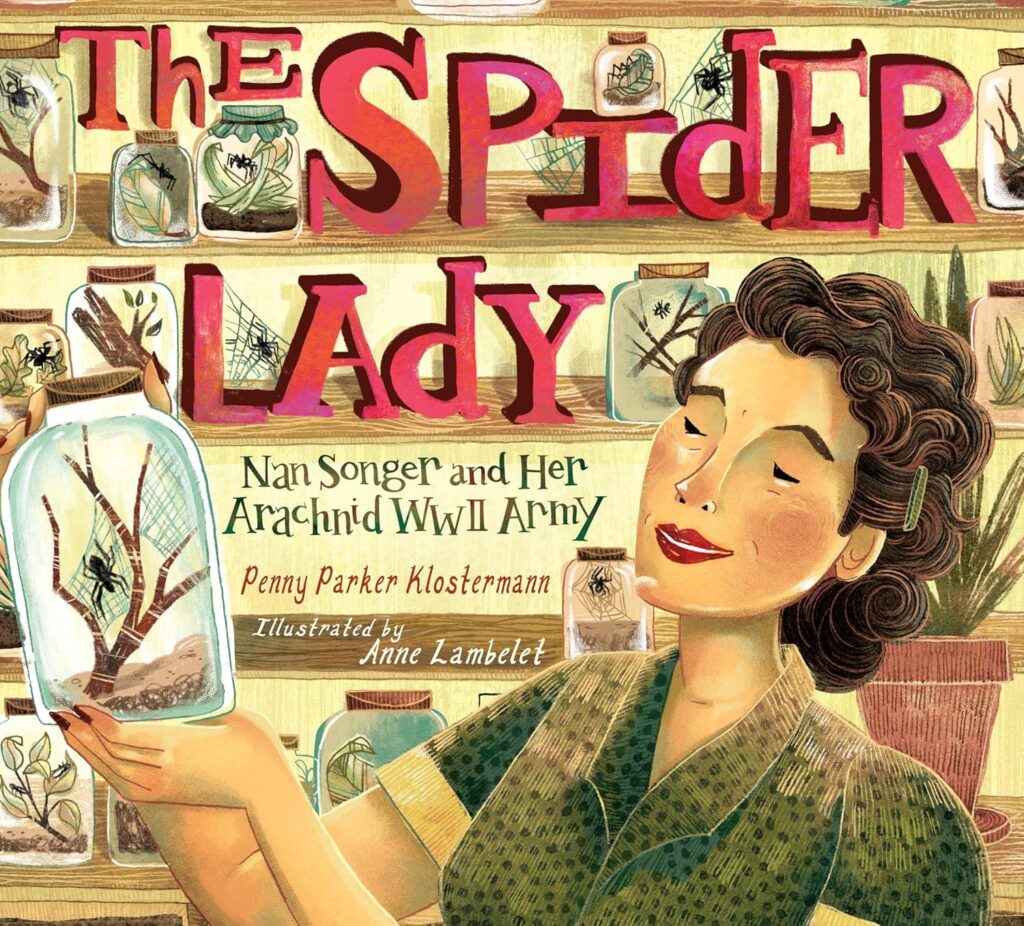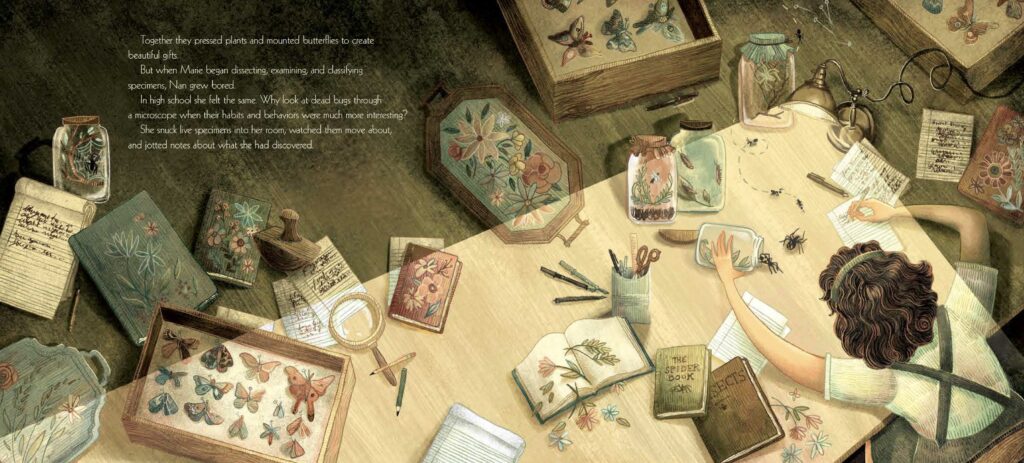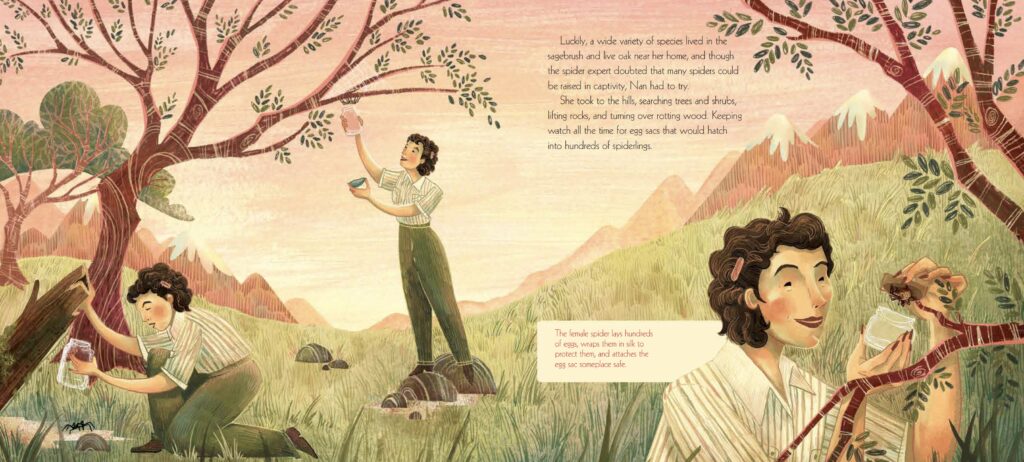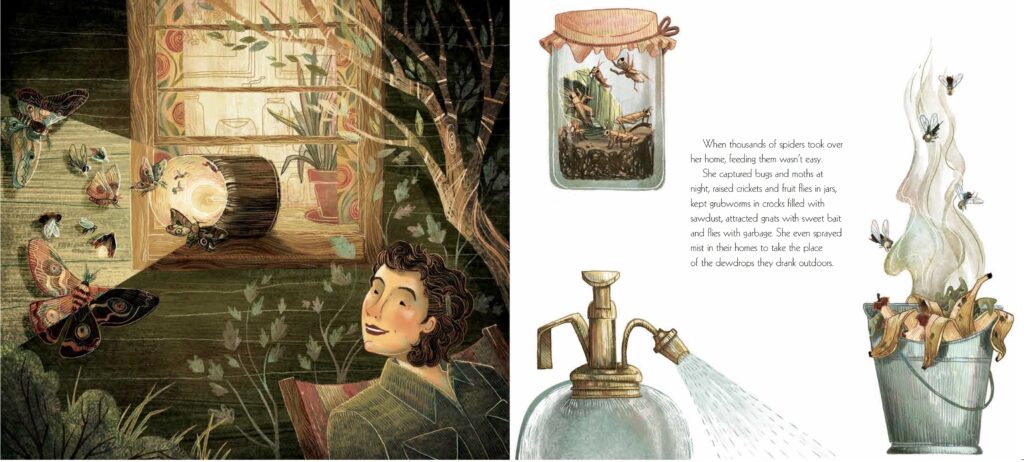Look at this baby, would ya? SO APPEALING. Even if you weren’t a fan of spiders, I think you’d want to open this book and read about this woman who seems so confident with all. those. spiders she’s clearly keeping for some reason.

Penny mentioned this story to me a few years ago, right after she’d snagged the interest of Carolyn Yoder at Calkins Creek/Astra. I’ve been looking forward to the book ever since. And, wow, friends. The finished product is even better than I’d imagined. Most of the things I love about this book I mentioned in the interview questions I sent Penny recently, so rather than talk about them here, let’s just get to that interview! Penny has such fabulous (and inspiring!) info to share with us. I’m not even going to tell you what the book’s about. You can discover that below. More fun that way!
Jill: Penny, this feels like a “cheat” interview, since I’ve heard a lot about this book’s journey all along the way. But I KNOW our readers will be just as fascinated as I was. So, tell us, friend, how did you first stumble upon Nan Songer’s story?
Penny: I’d signed up for posts from Wonderopolis, a website which features a daily question/wonder and explores it. It’s geared toward children and is a quick, interesting read. Late in 2017 the question of the day was, “How Did Spiders Help the Allies Win World War II?” That question would catch anyone’s attention, right? The article explained that spider silk was used for the crosshairs in scopes. I had absolutely no idea that spiders were involved in WWII and wanted to know more. I was off on a down-the-rabbit-hole journey. As I continued on that journey, the name Nan Songer kept popping up. and as I read about her harvesting silk from spiders, I felt that everyone should know about her contribution to the war.
Jill: Yes! A click-bait question for sure. The further I went into this book, the more astounded and impressed I was with Nan Songer’s tenacity. And YOURS. There’s so much you had to learn about Nan and spiders to put this story together. It must have felt like information overload at so many points. I may have thrown in the towel. Can you tell us what kept you going when your research just kept giving you more, More, MORE?

Penny: Determination! I’d never written a nonfiction book and I felt lost but something inside me just had to write this book! It turned out to be a huge learning curve for me and my drafts were reading like journal articles. I believe in mentor texts and learning from them helped me make progress with each revision. I enjoy writing poetry so when I read a mentor text that was very lyrical I decided to try that with my story. To me, lyrical text is much like a free verse poem and when my mind is in poetry mode, I find it easier to cut words. I’m not sure why that works for me but I’ll take it. I made a big leap forward and the manuscript went on submission. Carolyn Yoder at Calkins Creek wanted it and I was thrilled because I’d heard great things and I love books that she’s edited. But she and the team saw Nan Songer as a woman of action who had to figure out the ins and outs of harvesting silk quickly to fill with World War II looming. After listening to her I knew she was the right editor for this book and I agreed to rewrite the story. Lots of revision followed and some new exercises for me. The story was just getting stronger and stronger but Carolyn knew it could be better. She strongly suggested I paginate my manuscript. Pagination is numbering the spreads as you think about pacing, rising tension and page turns, three important things to keep readers engaged. I’d paginated in the past but never for an editor’s eyes so I took it very seriously, hoping for progress. It paid off in a big way. The manuscript was much closer.
Next, she strongly suggested I make a physical dummy. I resisted at the time, telling her that I hadn’t made physical dummies with my previous books and that it seemed like paginating was about the same thing. I also told her I’d made a digital dummy with PowerPoint. But she urged me to make a physical dummy, telling me I would learn from it. She said the dummy would help me to notice spreads that might be text heavy and that it would further improve my pacing and page turns. So I made a paper dummy. I’ll admit I was kind of rolling my eyes because how could this help more than a digital dummy? Well it WAS!
What a HUGE difference! Things just jumped out at me. I marked it up and cut nonessential words. In fact, the physical dummy was so beneficial that after applying the revisions to my manuscript, I made a second dummy and then a third!!! Physical dummies are the bomb!!!
Carolyn also wanted me to explore moving back matter facts and info to sidebars within the story. I think it helped me question what back matter was most relevant to the story when I considered where a sidebar would best serve what was happening in the story. I’m so happy with that aspect of the book.

Jill: YES. Your eye-rolling comment made me laugh out loud, because I have a tendency to do that myself. Fortunately, Carolyn is an insightful and patient teacher. (And dang, if she’s isn’t always right.) (Re backmatter, I have come to love writing that as much as the body of a book. Don’t shy away from it, people!) Penny, I remember that something happened to help you go even deeper with Nan’s story. Could you tell us about that?
Penny: Yes!!! It was so exciting. Carolyn and I were on a Zoom call talking about the next revision and I told her that Nan had written a manuscript that was never published. I’d tried and tried to find a family member that might know something about it but hadn’t had any luck. She said you have to find it. Her exact words were, “You have to be a pest!” I found that very funny since so many people think spiders are pests. (They’re not! They’re amazing!)
Previously, my lead was Nan’s daughter’s name but she was no longer living. I talked to people who the daughter had worked with in Christmas Valley, Oregon and they tried finding a family member. No luck. Then I tried finding the daughter’s ex-husband. I hadn’t found an obituary for him and tried every address and phone number connected to him in Christmas Valley. No luck.
Carolyn told me to be a pest and the time had come to go all out pest. So my pesty self broadened the search to other states. I came up with a lot of results to narrow down because there were many variations of his first name matched with results that included his last name. Pesting on, I cross-referenced by age and such until I felt certain I had narrowed it down. With new addresses came new phone numbers and new names of people who might have lived at one or more of his addresses and/or might be related to him. Pest Alert! I called anyone and everyone who might have ever lived at any or every address where the ex-husband had ever lived. If someone answered, I spoke fast before they could hang up. “Do you know of Nan Songer?” Then, one afternoon, “Do you know of Nan Songer?” “Yes,” answered a lady! I hit pay dirt in California!! The lady was the daughter of the ex-husband. She connected me with Jason, Nan Songer’s great-grandson. He had the manuscript, Nan’s research and a ton of photos. He was excited that I was writing a story about his great grandmother and offered to let me copy everything. He lived in Oregon so I flew there and came home with treasure. I got to know Nan through her writing and what I learned added rich details to the story.
Jill: “Pesting on…” 🙂 Yeowser, the research never ends. But what a payoff! Amazing. Let’s talk illustrations. Anne Lambelet’s spreads are spectacular, and her color palette … the soft peaches and greens of every shade, the pale yellows and blues … GORGEOUS. And the quirkiness of her style and attention to detail … again, wow.

Penny: I love Anne’s art so much. She uses a lot of texture which I adore. Look at the texture in Nan’s clothes, the trees, plants, grasses … I could go on and on. She did a fantastic job and I’m thankful that she agreed to illustrate the book. I was shown the color palette and LOVED it! I gave input on a few items in early art that wouldn’t have been invented at that time like a spiral notebook and a soda can. There were a few things about Nan’s process of gathering silk that needed small tweeks. I caught a couple of things about the spiders that I’d learned in my research, but the spider expert that weighed in is the one who made sure the spiders were accurate. I had a lot of fun checking the details and I think Anne did too because she got every tiny thing perfect. I’m so proud of how this book came together.
Jill: Spider Lady is such a departure from your fiction picture books, Penny. Do you have more nonfiction in the works, or are you focusing on more fiction, for now?
Penny: Because I did a lot of research on spiders to better understand Nan’s work, I learned some very cool information about spiders and the astonishing things they do. So, I’ve started an informational fiction book starring spiders and continue to work on fiction.
Jill: Another great take-away. Reuse, recycle! Can’t wait to see what you come up with, Penny. Thanks for taking the time to do this interview for me.
Readers, please feel free to leave a comment for Penny, below. Annnnd, doing so will automatically enter you in our giveaway. Astra has generously agreed to send one lucky winner a copy of Spider Lady! Continental U.S. addresses only, please, and they cannot send to P.O. boxes. Good luck!
WINNER! The winner of Charlotte Gunnufson’s HARD HAT HANK is Judy Sobanski! Congrats, Judy! Charlotte will be contacting you soon.

Wow,
Thank you for sharing The Spider Lady, looks fabulous, those illustrations are wonderful.
I’m looking forward to reading this — she sounds fascinating! And the illustrations look amazing!
There should be a book about writing this book -“the author who would not quit!” What wonderful research – and outcome!